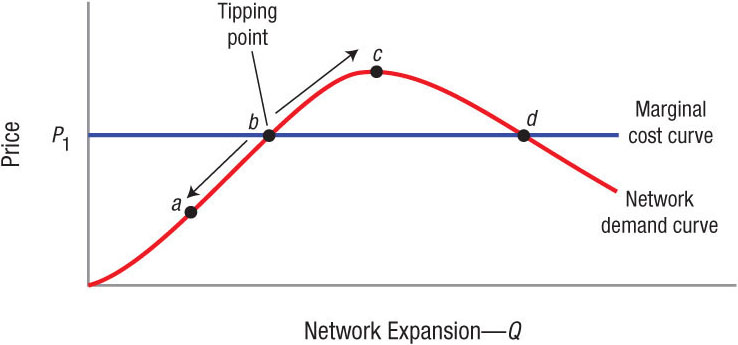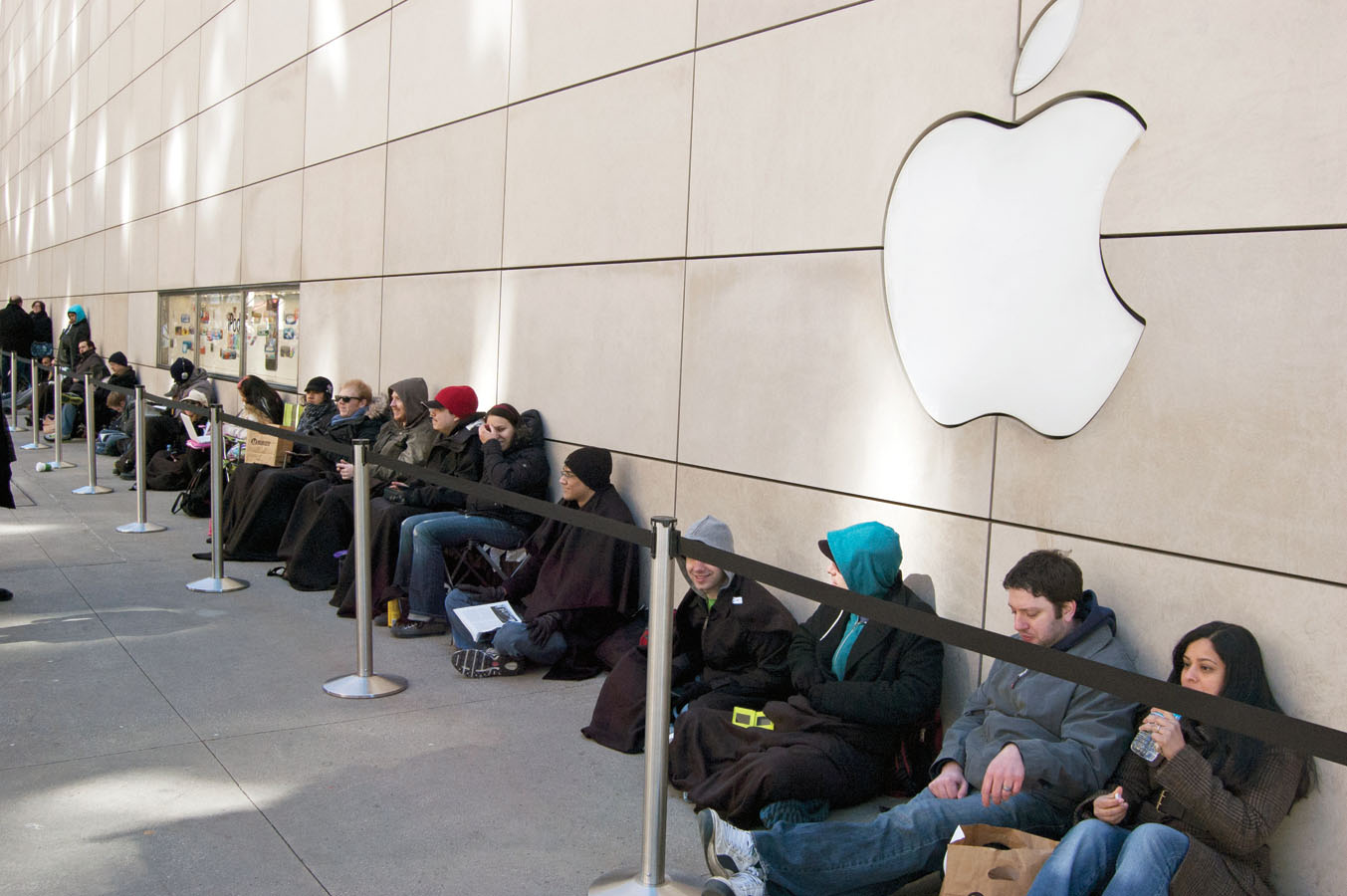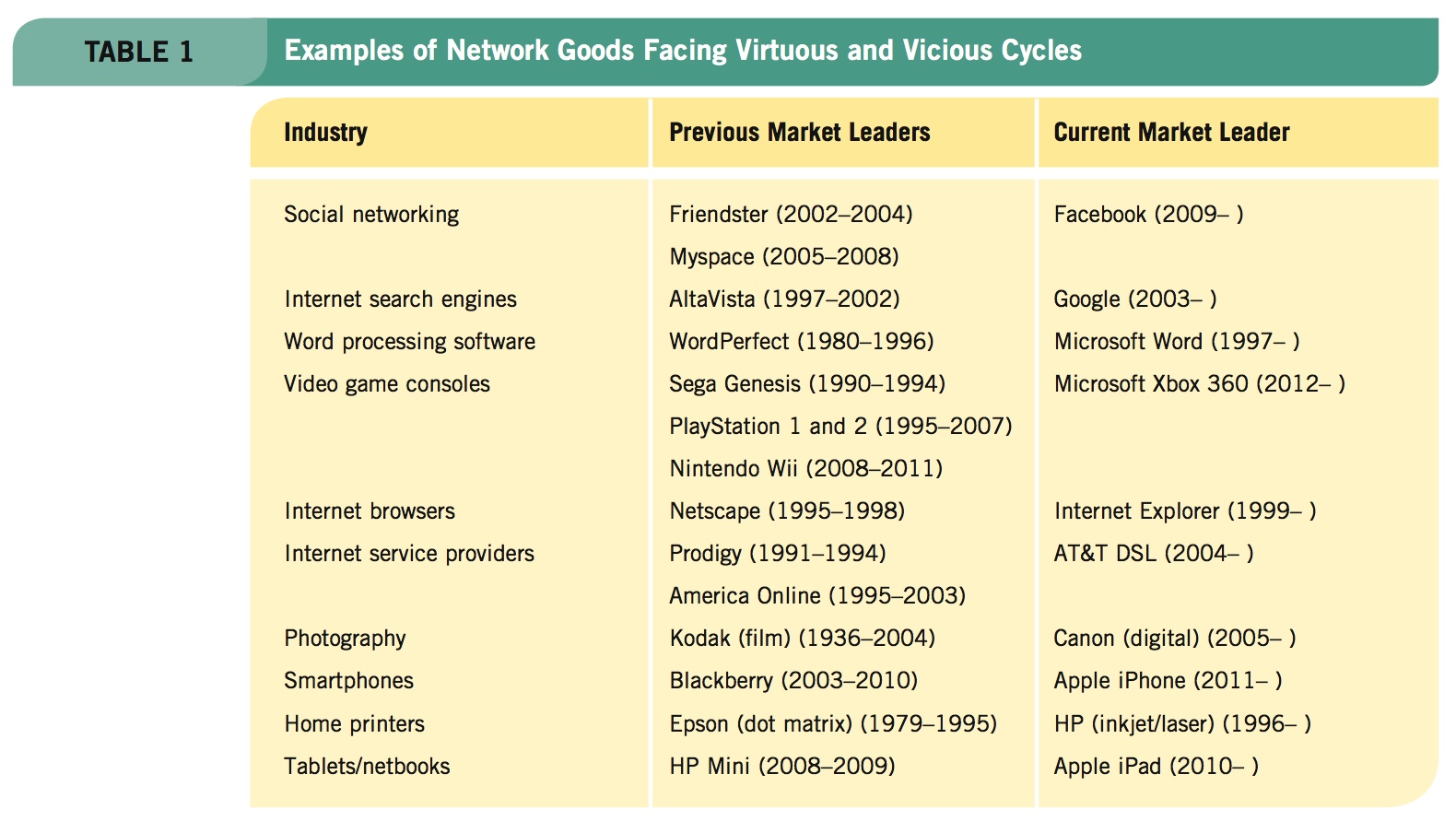Market Equilibrium for a Network Good
Now that we have learned how a network demand curve is developed, we can study how market equilibrium is reached in this type of industry. The market equilibrium for a network good occurs once most network effects are realized. Therefore, equilibrium generally is found on the downward-sloping portion of the network demand curve. However, not all network goods reach market equilibrium. As we will soon see, network goods can thrive or fail over a short period of time, making market equilibrium difficult both to achieve and to sustain.
Economies of Scale and Marginal Cost
An important characteristic of network goods is that they generally require a very large fixed cost to produce. Fixed costs can include the cost of writing and producing a new hit song, or the huge cost of building cell phone towers across the country. In Chapters 9 and 10, we saw how monopolies and oligopolies can form when industries exhibit high fixed costs and low marginal costs. Network goods are an excellent example of goods produced in such industries, for once a song is produced or a cell phone tower is built, the cost to serve customers (a firm’s marginal cost) is minimal. An outcome from this type of industry is large economies of scale.
Finding an Equilibrium in the Market for Network Goods
tipping point (or critical mass) The quantity from which network effects are strong enough to support the network.
Let’s assume that the marginal cost of a network good is fixed at P1, as shown in Figure 4. The equilibrium is point d, the intersection of the downward-sloping portion of the network demand curve and the marginal cost curve. To achieve equilibrium, the network for that good must expand from the origin to point b, which is called the tipping point (or critical mass), the quantity from which network effects are strong enough to continue building the network.
FIGURE 4
Equilibrium in a Market for Network Goods Point b represents the tipping point—the point at which the network has achieved enough momentum to continue expanding until it reaches point d (an equilibrium created by a virtuous cycle). However, if a market fails to reach point b, a vicious cycle may result, leading to a collapse in market share.
virtuous cycle The point at which a network good reaches its tipping point, when network effects cause demand for the good to increase on its own. As more people buy or subscribe to a good or service, it generates even more external benefits and more demand.
vicious cycle When a network good does not reach its tipping point, and therefore does not increase in value enough to retain its customers, customers leave the network, thereby further diminishing the value of the good until all customers leave the network.
Once a network reaches point b, the existence of network effects will continue to generate more demand, allowing the network to expand on its own until it reaches equilibrium at point d. This is referred to as a virtuous cycle, in which network effects push demand farther to the right, creating even more value for the network.

However, if a network good fails to reach point b, or if a new competing network good causes demand to move to a point left of point b, a vicious cycle can result. In a vicious cycle, people stop consuming a product or service, thereby reducing the value of the product to others, which causes even more people to avoid consuming the good. The result is typically a failed product, shown as a good at point a in Figure 4.
An example of a product entering a vicious cycle was the HD DVD format introduced by Toshiba in 2006. Toshiba competed vigorously for market share against Sony’s Blu-ray format, but because Toshiba did not reach a critical mass, studios stopped offering their movies in HD DVD format, leading to a vicious cycle and the discontinuation of the format in 2008. Interestingly, several years later Blu-ray entered its own vicious cycle as online streaming of movies made physical media less relevant, leading to fewer movie offerings in Blu-ray format and a steep drop in sales.
Note how the network demand curve slopes upward to point c, then downward. What explains this change in slope? Point c represents the point of product maturity, when the network effect no longer dominates the price effect. Remember that a demand curve slopes downward due to a price effect—it requires a lower price for people to consume more. However, network effects counter the price effect by raising the value of the good as consumers buy more. At point c, the network effect and price effect are equal in magnitude. Thus, the upward-sloping segment represents core users who are less price sensitive, and the downward-sloping segment represents casual users who are more price sensitive.
Networks Goods Can Face a Virtuous Cycle or a Vicious Cycle Very Quickly
The speed at which network effects can influence the success or failure of a product or service can be remarkably fast. As shown in Figure 4, once a firm enters a vicious cycle by moving down the network demand curve to the left of point b, it is often difficult to stop the cycle. Meanwhile, firms entering virtuous cycles enjoy what seems to be limitless growth over a very short period.
Table 1 provides examples of network goods that experienced a change in market leader at some point over the last two decades. In some cases the change was gradual (such as the transition from film to digital, because ardent film photographers took many years to make the switch to digital), whereas in other cases the change was almost instantaneous (such as that from the HP Mini to the Apple iPad).

Interestingly, the quality of a network good is not always the most important factor in determining the market leader in a network industry. Because network effects are so powerful, consumers sometimes choose an inferior product that many people use over a superior product that fewer people use. For example, some video game enthusiasts claim that Sony’s PlayStation 3 is superior in graphics and capabilities to Nintendo’s Wii. Yet, the Wii system held its position as market leader for four years, partly due to its lower price but also due to a virtuous cycle it had enjoyed until Microsoft’s Xbox 360 took over as the new market leader.
The Broadband Effect: Virtuous and Vicious Cycles in Network Goods
Most Americans rely on broadband Internet connections for work, school, or entertainment. Over 66% of U.S. households in 2012 had a broadband connection, up from just 11% in 2002. Part of this dramatic rise in broadband connectivity has been the result of government efforts to promote broadband usage in all areas of the country, especially in rural areas where it is costly to establish broadband connections.
In 2010, the U.S. Federal Communications Commission (FCC) established the Connect America Fund to promote the goal of ensuring that every household has access to broadband capability. This fund consists of fees collected from all broadband users nationwide and is used to subsidize service in high cost areas such as rural and mountainous communities. The FCC lists the social benefits of such an effort as including improved education, health care, public safety, and civic engagement in rural areas. These ultimately benefit the entire nation.

No doubt, the near universal use of broadband has resulted in significant changes to network industries. For example, network services such as movie and live television streaming, online conferencing, worldwide telecommunications via Skype and other online providers, and instant music and software downloads were all either previously unavailable or excruciatingly time-consuming to use prior to broadband. These services experienced a virtuous cycle as more and more consumers gain access to faster Internet connections, leading to a validation of Metcalfe’s Law, which states that the value of a telecommunications network increases exponentially with the number of users.
But not all industries fared well with the rise in broadband usage. Some markets faced a vicious cycle as consumers moved away from certain network goods. These include traditional international calling, calling cards, and prepaid phones. Beyond telecommunications, broadband also contributed to the demise of most physical DVD and game rental stores, CD music stores, and software stores, as all of these services can now be obtained online.
Like all industries, goods come and go, and network goods are no different. What is remarkable is how quickly this transformation took place over the last decade. How today’s network goods fare in the future will be an interesting question to examine as technological improvements continue to change the way we live.
Because of the speed at which market demand for network goods can occur, no firm is ever “safe” with its market share. Aware of this, businesses often engage in various competitive strategies to increase or secure their market shares. The next section describes some of these strategies.
MARKET EQUILIBRIUM FOR A NETWORK GOOD
- Network goods generally exhibit large economies of scale due to their high fixed costs and low marginal costs of production.
- A network good must reach its tipping point (or critical mass) to enter a virtuous cycle in which network effects generate additional demand until equilibrium is reached.
- Network goods that do not reach their tipping point enter into a vicious cycle, leading to a sharp decline in market share and likely failure of the good.
- Network goods can enter virtuous or vicious cycles in a very short period, such that no good is ever safe from rapid decline.
QUESTION: In 2003, Myspace entered the market and quickly became the world’s most popular social networking site. In 2006, with more than 100 million subscribers, Myspace appeared destined to be a successful company over the long run. Enter Facebook, which had been introduced two years earlier as a niche social networking site for college students. Facebook quickly expanded beyond college students to target all consumer markets, and by 2009 Facebook surpassed Myspace, which has since seen a steady decline in subscribers. How does the network demand curve explain the speed at which Myspace rose to prominence and then fell to relative obscurity?
The network demand curve shows how a good enters a virtuous cycle (where an increase in demand generates network externalities that lead to additional demand) and how it enters a vicious cycle (where a decline in demand reduces the value of the network that leads to further declines in demand). When Myspace was introduced in 2003, it provided new features that its competition (primarily Friendster) didn’t offer, and quickly led to a virtuous cycle in which the growth in subscribers increased exponentially over several years. When Facebook entered the market and captured the attention of social networking users, it quickly entered a virtuous cycle as well. Once users began choosing Facebook over Myspace, the drop in Myspace subscriptions quickly led to a vicious cycle and a significant drop in market share.